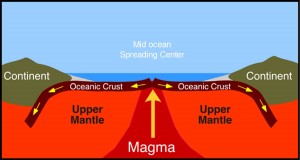Below is a diagram that was never shown to me in science class. Alfred Wegener proposed his theory of continental drift in 1912, but it was not until 1960 that most scientists began to accept the new paradigm that continents move around. The idea of crust formation at mid ocean ridges came even later in 1966. So when scientists and teachers in the 1950s and 1960s presented a story about the serpentine rock underlying Soldiers Delight, they got it wrong. Serpentinite is formed in the lower oceanic crust, typically at the mid ocean spreading centers. That’s where it picks up its heavy minerals, like chromium, nickel, and magnesium, which are more abundant in the mantle and deep crust. When Africa floated over here 300 million years ago, a little bit of this oceanic rock got pushed along with it and ended up in the Appalachian Mountains, and in Soldiers Delight. Nobody knew that in 1960.


